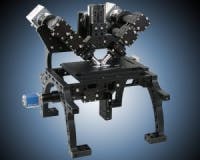ASI to showcase selective-plane illumination microscopy system at SPIE BiOS 2015
The company's dual-inverted selective-plane illumination microscopy (diSPIM) system uses two water-immersion objectives mounted at 45° angles above the sample on an inverted microscope; a third objective also can be used to view the sample from below. The top objectives are mounted on piezo positioning devices to obtain precise image stacks. The system generates 3D volumes with isotropic resolution (330 nm in all direction) and delivers acquisition rates up to 200 images/s or 2-5 volumes/s.
SPIE BiOS booth number: 8631
To Learn More:
Contact:Applied Scientific Instrumentation (ASI)
Headquarters: Eugene, OR
Product: diSPIM system
Key Features: Acquisition rates up to 200 images/s
What ASI says:
View more information on the diSPIM system.
View More Products
Locate a vendor or system integrator in our Buyer's Guide.
Share new products that you think are particularly interesting or helpful by contacting Lee Dubay, Associate Editor, Laser Focus World.
